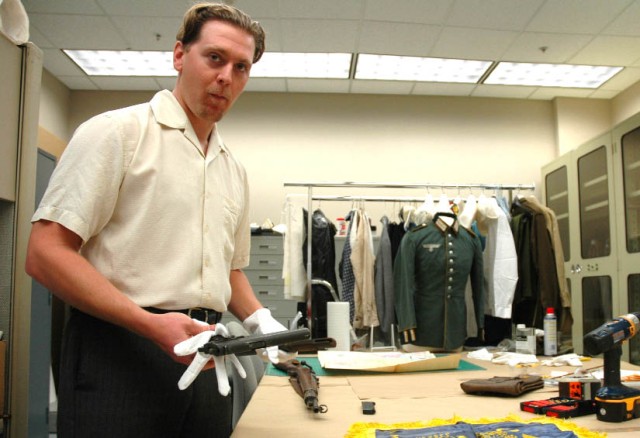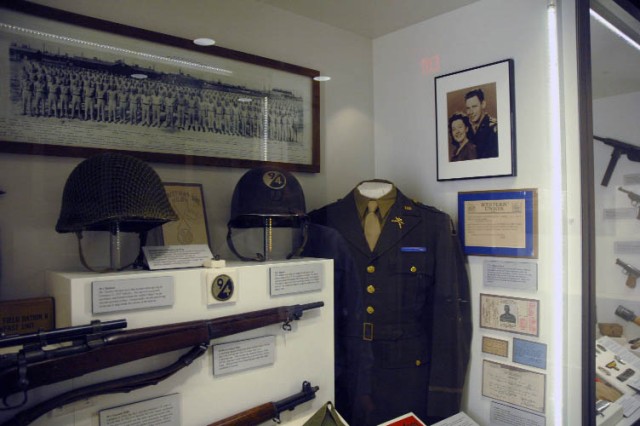FORT MCPHERSON, Ga. -- In the basement of the U.S. Army Reserve Command (USARC) Headquarters building, he lives on, despite having drawn his last breath more than 64 years ago.
Through the work of the USARC historians, the memory and account of 1st Lt. Maurice Myers, who served with the 301st Infantry Regiment, 94th Infantry Division, in World War II, and those of countless others, is still being kept alive.
"The Greeks said no one is truly dead until his or her face and name are forgotten," said Christopher Kolakowski, USARC museum chief curator. "That is what we're doing, keeping history alive."
Rather than let time stagnate and erase the skeleton of the past, the military historian adds flesh to the bones, clothes to the body and, most importantly, breathes life into the tale behind each subject.
"There's always a story beyond the artifact itself," Kolakowski said. "We tell those stories."
Much like the stories they tell, the work of military historians has quite a long tale behind it, almost as old as the history they study.
In ancient Greece, accounts of the 5th Century B.C. Peloponnesian War between Sparta and Athens survive because of the writings of historian Thucydides. Although the nature of war and means of collecting data have changed much in the past 2,500 years, the role of the military historians has remained fairly constant.
Just as Thucydides reported from the front line, today's Army historians are out with the troops, gathering firsthand accounts of conflicts, whether overseas in Iraq or Afghanistan or in America when responding to disasters, such as hurricanes and earthquakes.
"We're the point of the spear in Army history," said Lee Hartford Jr., a historian for the Army Reserve. "It's the most exciting place to be."
Exciting yes, but sometimes difficult, Hartford added, especially for historians like himself who focus on the Army Reserve.
"Unlike the regular Army with large divisions, the Army Reserve has smaller units, thousands of little units," he said. "It is hard to capture the history of all the units that go out."
Military history detachment teams capture the info and the task of training such detachments falls on longtime historians like Hartford, who has served as a USARC historian since 1992.
Describing these teams as "battlefield detectives," he instills in them how important their function is in collecting original important operational documents, such as maps, photographs, artifacts, taped audio interviews and video recordings.
"Without military combat historians, we wouldn't have history," Hartford said. "If we don't properly collect it, history gets lost."
The loss of such historical data can have dire future consequences, Hartford said. When today's leaders make plans and formulate strategies, they rely on the data Hartford provides.
Like the Center for Army Lesson Learned, which collects and analyzes data from current and historical sources to give lessons to military commanders, the historian's brief makes leaders historically aware of situations, so each operation isn't necessarily rebuilt from the ground up.
For example, the historical role of the Army Reserves in the Gulf War helped reserve leaders to support the current war efforts in Iraq and Afghanistan, Hartford said.
"The most important lesson of the Gulf War was the Army's increased dependence on the Army Reserve," Hartford said. "The Army can't go to war anymore without the Army Reserve. It is no longer a strategic reserve."
The Army historians' role in collecting artifacts and historical data also brings to light the one element in combat Hartford said never changes: humans. To chronicle Soldier narratives, historians sometimes get help from families, Kolakowski said.
The display documenting Myers, who was killed in action Nov. 13, 1944, during fighting in Brittany, France, contains his uniform, a photo of him and his wife, Helen, and the telegram announcing his death.
These items were donated by his family. More recently, the family of Staff Sgt. Keith Matthew Maupin, a Reserve Soldier with the 724th Transportation Company, donated his uniform for display in the museum.
Maupin was captured and killed by Iraqi insurgents after his convoy was ambushed April 9, 2004, near Baghdad. Such items enhance the power of the military historian, Kolakowski said.
"It's one thing to see it in a book, it's something else to stand in front of it," Kolakowski said. "It is a whole different experience."
"It conveys a sense of heritage, esprit d'corps and the Warrior Ethos," Hartford added. The pride and knowledge of a unit's history extends beyond the unit.
Hartford said research he and other military historians have collected is shared with authors and researchers looking to learn more, not just used to create in-house publications,.
"We're here for anyone who wants to do research. We send authors information they need," he said. "We share the legacy with the general public."






Social Sharing